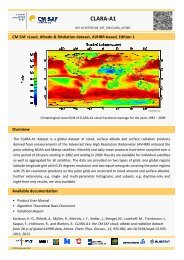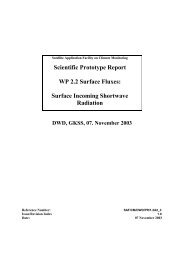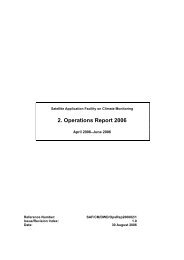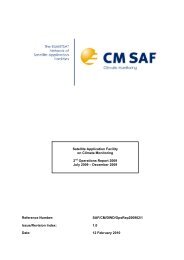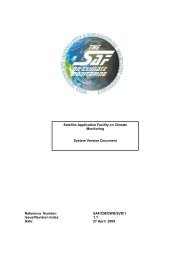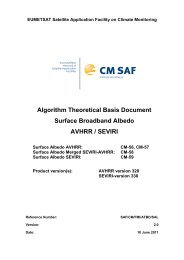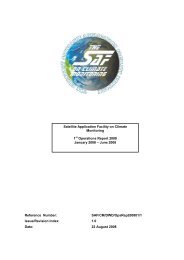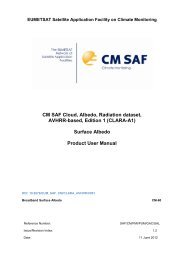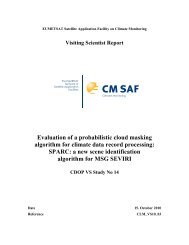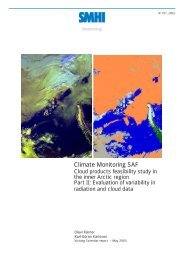Aerosol retrievals from METEOSAT-8 - CM SAF
Aerosol retrievals from METEOSAT-8 - CM SAF
Aerosol retrievals from METEOSAT-8 - CM SAF
Create successful ePaper yourself
Turn your PDF publications into a flip-book with our unique Google optimized e-Paper software.
<strong>SAF</strong> on Climate Monitoring Visiting Scientists Report Doc. No: 1.0<br />
Issue : 1.0<br />
Date : 4 October 2006<br />
sampling of the surface BRDF and/or the aerosol phase function<br />
Beside the above-mentioned new aspects that are especially dedicated to MSG/SEVIRI, it is also<br />
possible to use more classical methods. First, for MERIS a method is used that links the vegetation<br />
index empirically to surface reflectance. The lack of a blue channel on SEVIRI will reduce the<br />
vegetation index mostly to an NDVI, which is not independent of atmospheric turbidity. Thus<br />
NDVI is not a robust index for the prediction of the surface reflectance if it is computed <strong>from</strong> a<br />
single observation. However, a spectral index built with multiple views, and using information <strong>from</strong><br />
the blue part of the spectrum of the High Resolution Visible (HRV) channel should not be<br />
discarded. Nevertheless, the use of the HRV channel is not trivial and studies are needed to<br />
investigate methods to separate the reflectances in blue <strong>from</strong> the HRV channel reflectances. Second,<br />
the MODIS like approach that uses visible surface reflectance at 670 nm <strong>from</strong> the channel at 1600<br />
nm (King et al. 1992). This approach has been described in an early stage of the operational<br />
algorithm for the Land<strong>SAF</strong>. To our knowledge no application of this method on real MSG data has<br />
been published. Finally, in particular conditions where one can assume that the aerosol model and<br />
loading vary little in time, it is possible to use consecutive observations with different sun zenith<br />
angles and, according to the reciprocity principle, retrieve aerosol properties. This approach follows<br />
the principles AATSR or MISR algorithms that are designed for multiple view angles. Note that the<br />
paper devoted to Meteosat by Pinty et al., (2000) describes a method to derive surface albedo by<br />
decoupling surface and aerosol contribution <strong>from</strong> a set of images acquired during the day, following<br />
a method close to the MISR algorithm. However, the main constraint of this method is that the<br />
geophysical system shall not vary much during the day, which contradicts with the wish to use<br />
MSG as a tool to measure the rapidly changing aerosol fields.<br />
- 16 -



